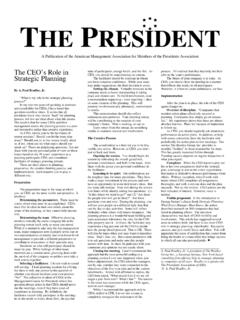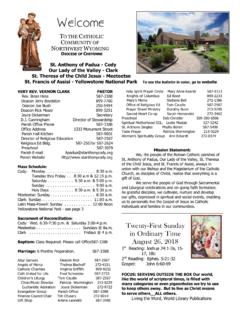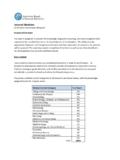Transcription of Dental Management of Patients with Osteoporosis
1 Dental Management of Patients with Osteoporosis New Mexico Health Resources Providers retreat May 20, 2011 Dr. Peter Jensen, DDS, MS, MPH Dr. Charles Tatlock, DDS, MPH Department of Dental Medicine University of New Mexico Osteoporosis More than 30 million people in the US 24% of Patients with osteoporotic fractures not treated will die because of these fractures At present, bisphosphonates are the best tool to reduce bone loss and significantly reduce the chance of these fractures USC study: 96% success rate of people using oral bisphosphonates with Osteoporosis What are Bisphosphonates? First approved and released in 1970 Introduced over 20 years ago as toothpaste additive (pyrophosphates) Target areas of high osteoclast activity Re-establish balance between osteoclast and osteoblast activity First clinical reports of oral necrosis were published after 2003 What is the Mechanism of Action?
2 Exact mechanism is unknown Results in inhibition of osteoclast activity- suppressing bone turnover Bisphosphonates purpose = to inhibit bone resorption -disrupts osteoclastic activity & osteoclast precursors 2. Nitrogenous forms are integrated into hydroxyapatite crystals and blocks resorption Bisphosphonates 3. Not metabolized -either incorporated or eliminated (may take decade) 4. Also disrupts normal bone turnover and bone healing 5. Decreases serum Ca+ Bisphosphonates 3. Not metabolized -either incorporated or eliminated (may take decade) 4. Also disrupts normal bone turnover and bone healing 5. Decreases serum Ca+ Properties of Bisphosphonates Poor intestinal absorption Highly selective Prolonged storage in bone (half-life may be years) Types of Bisphosphonate Drugs Nitrogenous forms Zometa/Reclast (Zolendronate) IV Aredia (pamidronate) IV Fosamax (alendronate) PO Boniva (ibandronate) PO Actonel (risendronate) PO Skelid (tiludronate) PO Non-nitrogenous -Didronel (etidronate) IV/ PO -Bonefos, Loron, Ostac (Clodronate)
3 IV/ PO Indications for Bisphosphonates Osteoporosis Chronic steroid therapy Paget s disease of the bone Cancer metastasis to the bone Multiple myeloma Hypercalcemia in cancer Patients Contraindications Pregnancy Children Renal insufficiency/ pre-existing renal disease Low serum calcium levels Osteomalacia Esophageal reflux disease Patients at bed rest who cannot stand up for at least an hour Benefits Prevents further bone damage and hypercalcemia Reduces bone pain and pathologic fractures Improves quality of life, healing time and strengthens bone Side Effects Fever Phlebitis Malaise Kidney dysfunction Headache Dementia Nausea/emesis Diarrhea Esophageal irritation Osteonecrosis New Class of Drugs Associated with ONJ Denosumab (Prolia)- anti-receptor activator of nuclear factor-kB ligand (RANKL) FDA approved for postmenopausal women with Osteoporosis at high risk for fracture Supplied as injection for subcutaneous use Works by decreasing bone turnover, resulting in significant increase in bone mineral density ONJ noted in doses of 120 mg per month in cancer Patients Source: Wynn, (2011) General Dentistry.
4 January/February; 10-12 Osteonecrosis What is osteonecrosis? How do bisphosphonates cause osteonecrosis? What is the incidence of osteonecrosis? Who might develop osteonecrosis? What are the treatments for osteonecrosis? Can you prevent osteonecrosis? What is Osteonecrosis of the Jaws? Exposed bone in the maxilla or mandible A disruption of the resorption and remodeling cycle of bone Poor blood supply to affected area Non-healing extraction socket or exposed jawbone with progression to sequestrum formation associated with localized swelling and purulent discharge Definition of ONJ American Society of Bone and Mineral Research (ASBMR) and American Association of Oral and Maxillofacial Surgeons (AAOMS) or previous treatment with a bisphosphonate necrotic bone in the maxillofacial region, present for at least 8 weeks history of radiation therapy to the jaws Clinical Picture of Osteonecrosis Panorex How do Bisphosphonates cause Osteonecrosis?
5 The pathogenesis is consistent with localized vascular insufficiency Mechanism of compromising bone vascularity related to osteoclasts Pamidronate depresses bone vascularity in laboratory rats Antiangiogenic properties shown by Wood et. al Who might develop Osteonecrosis? Patients on pamidronate or zoledronic acid (nitrogen containing bisphosphonates) Predisposing factors Age Radiation therapy to the jaw region Medications steroids Underlying Dental problems Tooth removal or local factors Dental implants or fillings Thin, friable mucosa Risk for ONJ Oral bisphosphonate use for Osteoporosis : , with a risk after a Dental extraction IV bisphosphonate use for malignancy , with a risk after a Dental extraction Source: Boromeo, GL, Tsao, CE, Darby, IB, Ebeling, PR (2010). A review of the clinical implications of bisphosphonates in dentistry.
6 Australian Dental Journal: 56 (1): 2-9 Risk of ONJ Horizon study (Health Outcomes and Reduced Incidence with Zoledronic Acid Once Yearly) N= 5,903 osteoporotic women, mean age= 73 y. matched to 5,140 control subjects (placebo) Incidence: One case of ONJ across both groups Risk described as negligible Sources: Grbic JT, Black DM, et. al. (2010). The incidence of osteonecrosis of the jaw in Patients receiving 5 milligrams of zoledronic acid: Data from the Health Outcomes and Reduced Incidence with Zoledronic Acid Once Yearly clinical trials program. JADA 141(11):1365-1370. November, 2010 Black, DM, Delmas, PD, Eastell R., et. al., (2007). Once-yearly zoledronic acid for treatment of postmenopausal Osteoporosis . N Engl J Med; 356 (18): 1809-1822 Risk of ONJ Patients treated for Osteoporosis with oral or IV bisphosphonate regimens Risk: Less than 1 per 100,000 person-years of exposure CONCLUSION: BN use for Osteoporosis is not in itself a contraindication to oral surgery or Dental implants Sources: Kahn, AA, Sandor, GK, Dore, E.
7 , et. al. (2009) Canadian Taskforce on Osteonecrosis of the Jaw. Bisphosphonate associated osteonecrosis of the jaw. J. Rheumatol.; 36(3): 478-490 Pazianas, M., Miller, P., Blumentals, WA, Bernal, M., Kothawala, P., (2007) Clin. Ther; 29(8): 1548-1558 Management of Dental Patients on Bisphosphonates and the Management of ONJ From Bisphosphonate Therapy Topics to be Covered Management of Patients with BRONJ Staging of the Disease Common Management techniques Dental Management of Patients on BP therapy Patients on oral BP Patients on BP Use of implants while taking BP Case Report Ethical and Professional Dilemmas Cross Section of Bone Definition of BRONJ The presence of exposed bone in the maxillofacial region that does not heal within eight weeks after identification by a healthcare provider. At Risk Category: Stage 0 No apparent exposure/necrotic bone in Patients who have been treated with either oral or IV bisphosphonates No treatment indicated Patient education Patients can have odontalgia, bone pain, sinus pain, paraesthesia/dysesthesia, neuropathic pain Radiographic Findings: Stage 0 Alveolar bone loss Bone resorption Changes in trabecular pattern (dense woven bone, persistence of unremodeled bone in extraction sockets) Thickening/obscuring of PDL with thickening of lamina dura, decrease PDL space Inferior alveolar canal-narrowing Pts with BRONJ: Stage 1* Exposed, Necrotic (sequestra) Bone that is Asymptomatic Txt: Peridex forever, no surgical txt, round/smooth rough edges with bone file/rongeur or bur *adapted from JADA, Vol.
8 140, January 2009 and Dr. Eric Tuggle Pts with BRONJ: Stage 2* Exposed Necrotic Bone (sequestra), Associated with Pain, Clinical Evidence of Infection Txt: Peridex forever, Penicillin, Clindamycin, Keflex, or 1st Generation Quinolones No surgical therapy unless mobile sequestrum, and extractions if within necrotic bone, and rounding of rough edges Refractory cases require long term AB or AB *adapted from JADA, Vol. 140, January 2009 and Dr. Eric Tuggle Antibiotic Regime for BRONJ Patient Type Suggested Drug Oral Regimen Not Allergic to Penicillin Amoxicillin May be combined with * Metronidazole 500mg 2X per day 14 days 250mg 3X per day 14 days Allergic to Penicillin Clindamycin Or Azithromycin 300mg 3X per day 14 days 250mg 1X per day 10 days *Amoxicillin may be combined with Metronidazole for maximum coverage of periodontal microflora Pts with BRONJ: Stage 3* Exposed necrotic bone (sequestra) , Pain, Clinical Evidence of Infection, and one of the following: Pathologic Fracture, Extra-Oral Fistula, Osteolysis extending to Inferior Border of Mandible or Floor of Sinonasal Cavity Surgical Resection/Debridment, *adapted from JADA, Vol.
9 140, January 2009 and Dr. Eric Tuggle Stage 2 and 3 Recommend Management by OMFS Strategies Treating Patients on BP s Pts about to start IV Bisph: Extract Non- Restorable/Perio Involved Teeth, Examine Dentures/Partials for Trauma. Incidence .8-12% of developing BRONJ Asymptomatic Pts receiving IV Bis: Good OHI, Regular Evaluations, Non Rest Teeth need coronectomy and endo therapy of the roots Asymptomatic Pts receiving Oral Bis: Elective Surgical Tx is not Contraindicated! Make sure you get informed consent and the patient is well educated. Incidence is . post extraction Patient Tx Strategies for Oral Bisphosphonates Less than 3 years txt: no change in txt, informed consent Less than 3 years and concominant steriod use: 3 month drug holiday is preferred prior to invasive procedures More than 3 years txt: 3 month drug holiday (if clinical/systemic conditions permit) Areas of Disagreement in Management Quick search of PubMed on ONJ and BP- 1244 articles and of those 261 Reviews 2 Main areas of disagreement Use of prophylactic AB prior to minor surgery for Patients on BP Discontinuation of BP treatment (if clinical situation allows) for tx of ONJ ADA expert panel and British Dental Association do not recommend prophylaxis Areas of Disagreement in Management Interruption of BP for 3-6 months recommended in Canadian Guidelines for nonemergency invasive Dental tx BDA recommends assessment on case by case basis No prospective studies assessing effectiveness of the treatments previously mentioned Implant Placement Retrospective Case Series: Patients on Oral BP Results.
10 26 implants placed in 21 osteoporotic women Time of BP therapy before and after placement, implant location, prosthetic type, & opposing dentition showed no statistical influence on clinical or radiographic parameters Conclusion: Being on BP before or after placement does not jeopardize osseointegration Shabestari, GO et al, Implant Placement in Patients with Oral Bisphosphonate Therapy: A Case Series, Clinical Implant Dentistry, Vol. 2, number 3, Sept. 2010; p. 175-180. Implant Study Small Study Some Patients (14) began BP after implant placement Probably can t extrapolate the results of this study to the clinical situation British Dental Association Factfile Recommendations Implants- Currently not contra-indicated if taking bisphosphonates but prudent to gain informed consent which should be documented (risk assessment) Case Report Patient missing multiple teeth Desires Replacement of teeth Multiple carious teeth High caries rate PMH: AIDS, Bisphosphonates, Medical Marijuana Imtec x 13 Implant BUT HOW IS THE PATIENT GOING TO PAY FOR IT?







